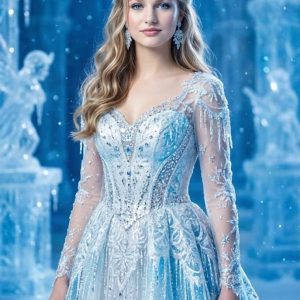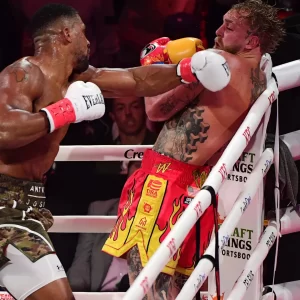Princess Kate Shines at Windsor Castle Gala in Phillipa Lepley Couture, Diana’s Lover’s Knot Tiara, and Queen Elizabeth II’s Jewels
On the evening of September 17, Windsor Castle once again became the stage for royal splendor as Catherine, Princess of Wales, made a breathtaking appearance at a state gala. Dressed in a bespoke gown by British couturier Phillipa Lepley, and crowned with the Lover’s Knot tiara famously associated with Princess Diana, Kate embodied both elegance and symbolism. Complemented by select jewels once worn by Queen Elizabeth II, her ensemble represented the continuity of royal heritage while showcasing her own growing stature as the future queen consort.
A Gown from a Modern British Designer
The couture gown was the work of Phillipa Lepley, a London-based designer renowned for her craftsmanship and romantic silhouettes. Known for her precision tailoring and attention to detail, Lepley has dressed some of Britain’s most glamorous women, but this marked one of her most high-profile royal commissions to date.
Kate’s gown featured a floor-length silhouette with a structured bodice and delicate embroidery, emphasizing the designer’s hallmark blend of classic formality and modern refinement. The choice of a British designer for such a high-profile event reinforced Kate’s dedication to supporting homegrown talent while also demonstrating her ability to balance tradition with contemporary style.
Fashion critics were quick to praise the gown’s understated opulence. The use of couture, rather than an international luxury house, underscored Kate’s position as a champion of British design. Commentators noted that the gown’s elegance was elevated further by its pairing with some of the most iconic jewels in royal history.
The Return of the Lover’s Knot Tiara
Stealing the spotlight was the Lover’s Knot tiara, a dazzling headpiece created in 1914 for Queen Mary and later beloved by Princess Diana. Featuring a row of diamond arches topped with pearls that dangle delicately from each loop, the tiara has long been one of the most recognizable symbols of royal femininity and power.
Princess Diana famously wore the Lover’s Knot tiara on numerous occasions during the 1980s and 1990s, though she often remarked on its weight and discomfort. After Diana’s passing, the tiara returned to the royal collection, rarely seen until Kate began wearing it at state occasions in recent years.
By donning the tiara at Windsor Castle, Kate once again aligned herself with Diana’s legacy, while also presenting it in a fresh light. The image of the Princess of Wales wearing the same tiara once cherished by her late mother-in-law resonated deeply with the public, serving as a poignant reminder of continuity and remembrance.
Jewels from Queen Elizabeth II’s Collection
Adding to the grandeur were jewels once owned by Queen Elizabeth II. Reports confirmed that Kate paired the tiara with a set of diamond drop earrings and a bracelet from the late monarch’s extensive collection. These pieces, chosen for their subtle sparkle, provided a direct connection to the Queen whose reign shaped modern Britain.
Pearls and diamonds have long been central to Elizabeth II’s jewelry style, symbolizing both resilience and timeless grace. For Kate to wear them alongside Diana’s tiara created a narrative of unity—three generations of royal women connected through shared symbols of duty and devotion.
Symbolism in Style
For the Princess of Wales, fashion has never been merely aesthetic. Her sartorial choices frequently carry symbolic weight, reflecting her role as a royal consort-in-waiting and as a global cultural figure.
At Windsor Castle, her ensemble spoke volumes. The Phillipa Lepley gown signaled support for modern British craftsmanship. The Lover’s Knot tiara linked her to Diana, evoking memory and legacy. The jewels from Elizabeth II reflected the lasting influence of the late monarch. Taken together, they created an image of a woman stepping confidently into her place as a central figure of the monarchy.
Royal historian Sarah Gristwood noted: “Kate’s choices are deeply deliberate. In one outfit, she paid tribute to her mother-in-law, honored the late Queen, and underscored her support for British fashion. It is style used as diplomacy, continuity, and commemoration all at once.”
The Setting: Windsor Castle
Windsor Castle, one of the most historic and beloved residences of the British monarchy, provided a fitting backdrop. The gala was attended by dignitaries, diplomats, and members of the Royal Family. Candlelight and the castle’s grand architecture enhanced the evening’s atmosphere of tradition and majesty.
As Kate entered the state apartments alongside Prince William, cameras captured a moment that blended personal grace with institutional symbolism. Observers remarked on her confidence and composure, qualities that have become hallmarks of her public role.
Public and Media Reaction
Media outlets across the world highlighted Kate’s look, with photographs splashed across front pages and social media feeds. Fashion commentators praised the harmony of her ensemble, calling it “a masterclass in royal dressing.”
On social platforms, hashtags celebrating Kate’s appearance trended internationally. Admirers praised her ability to honor both Diana and Elizabeth II in a single look, while others lauded her continued support for British designers. One post read: “Kate doesn’t just wear clothes—she tells a story. Tonight, that story was family, tradition, and grace.”
Balancing Modernity and Tradition
As the Royal Family navigates its new chapter under King Charles III, Kate’s role has become increasingly prominent. Her sartorial decisions carry diplomatic and cultural weight, shaping perceptions of the monarchy at home and abroad.
By blending couture from a contemporary British designer with historic jewels, Kate embodied the delicate balance the monarchy seeks: modern relevance rooted in historical continuity. This balance is seen not only in her fashion but also in her charitable work, public engagements, and the way she and Prince William present themselves as the face of a forward-looking monarchy.
Conclusion
The Windsor Castle gala on September 17 will be remembered not only for its grandeur but for the way Princess Kate used her appearance to weave together threads of history, symbolism, and elegance. In her Phillipa Lepley couture gown, the Lover’s Knot tiara of Diana, and jewels from Queen Elizabeth II, she created a tableau that honored the past while looking firmly to the future.
It was more than a fashion moment; it was a statement of identity and intent. As the Princess of Wales, Kate continues to show that she understands the profound power of symbolism, and that in every public appearance, she is shaping the evolving story of the British monarchy.






